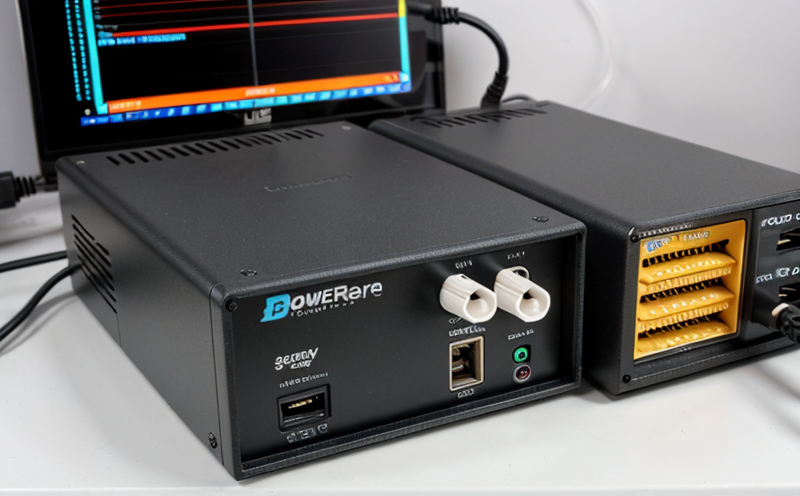ASTM E2219 Reliability Testing for Power Supply Components
The ASTM E2219 standard is a critical tool for ensuring the reliability of power supply components. This testing method evaluates how well these components can withstand environmental stressors such as temperature cycling, humidity exposure, and mechanical shock. It is designed to identify potential weaknesses or failures that could compromise system performance over time.
Power supplies are integral to numerous electronic devices across various industries including consumer electronics, automotive, aerospace, telecommunications, and medical equipment. Ensuring their reliability is paramount for reducing maintenance costs, enhancing product longevity, and maintaining operational efficiency. The ASTM E2219 test assesses the physical integrity of components under controlled conditions that simulate real-world usage scenarios.
The testing protocol involves subjecting samples to a series of cycles where they experience rapid changes in temperature followed by exposure to humidity. This process simulates the thermal cycling found during manufacturing and distribution, as well as potential operational stresses encountered in use. Mechanical shock tests further evaluate how components react to sudden impacts or vibrations.
By adhering to ASTM E2219 standards, manufacturers can demonstrate compliance with industry best practices while also safeguarding their reputation against product failures due to premature wear-out. For quality managers and R&D engineers responsible for ensuring high performance throughout the lifecycle of electronic devices, this testing method provides valuable insights into component reliability.
Testing according to ASTM E2219 helps companies meet regulatory requirements set forth by organizations like UL (Underwriters Laboratories) and CE marking directives. Compliance with these standards not only enhances market access but also builds trust among customers who value dependable products.
| Test Parameters | Environmental Conditions |
|---|---|
| Temperature Cycling | -40°C to +125°C |
| Humidity Exposure | 95% RH at 85°C |
| Mechanical Shock | 3g peak acceleration, 6ms duration pulse |
The testing procedure typically begins with thorough preparation of the specimen. This includes cleaning and conditioning the component to ensure accurate measurement results during the test. Once prepared, the sample is placed into a chamber programmed to follow the prescribed environmental profiles.
During each cycle, detailed monitoring equipment captures data on temperature changes, humidity levels, and mechanical stress imposed upon the component. After completion of all cycles, visual inspection along with functional tests determine whether any damage has occurred that would affect normal operation.
The resulting report provides comprehensive information about the tested components’ ability to withstand specified environmental conditions without failure. This documentation serves as evidence for compliance with ASTM E2219 standards and can be used during audits or when seeking certification from regulatory bodies.
Industry Applications
- Aerospace: Ensuring components survive extreme temperature variations in space environments.
- Automotive: Verifying power supplies operate reliably under fluctuating road conditions and temperatures.
- Telecommunications: Guaranteeing equipment remains functional despite harsh weather conditions.
- Medical Equipment: Providing assurance that critical devices function correctly even when exposed to challenging settings like hospitals or field operations.
The ASTM E2219 test is particularly beneficial for manufacturers who need to ensure their products meet specific reliability requirements. By incorporating this testing into their quality control processes, companies can improve overall product performance and reduce warranty claims associated with premature failures.
| Component Types | Tested Characteristics |
|---|---|
| Battery Chargers | Electrochemical stability, mechanical durability |
| Solid State Relays | Thermal resistance, switching speed |
| Switch Mode Power Supplies | Efficiency levels under varying loads, transient response times |
Eurolab Advantages
At Eurolab, we offer unparalleled expertise in performing ASTM E2219 reliability testing for power supply components. Our state-of-the-art laboratories are equipped with advanced instrumentation capable of replicating the most stringent environmental conditions outlined by this standard.
Our experienced technicians possess deep knowledge about both the theoretical aspects and practical applications of ASTM E2219, allowing us to provide accurate and reliable test results every time. We utilize cutting-edge software tools that help automate data collection and analysis, ensuring precision in our evaluations.
In addition to adhering strictly to ASTM E2219 procedures, Eurolab also offers additional services such as failure mode analysis and root cause investigation when issues arise during testing. This comprehensive approach ensures that clients receive complete insight into the reliability of their components before they reach market readiness.
Environmental and Sustainability Contributions
Incorporating ASTM E2219 compliance into your product development process can contribute significantly to environmental sustainability goals. By ensuring robustness against harsh operating conditions, you reduce the likelihood of field failures which lead to unnecessary replacements or repairs.
This reduced waste contributes positively towards minimizing electronic waste streams and supports broader efforts toward reducing carbon footprints associated with manufacturing processes. Moreover, compliant products enjoy extended lifecycles, thereby fostering circular economy principles by encouraging reuse rather than disposal after short usage periods.





